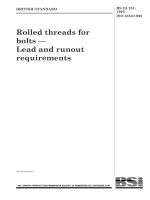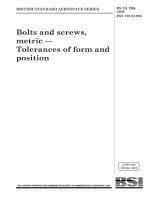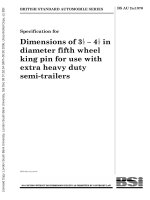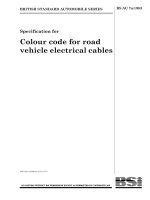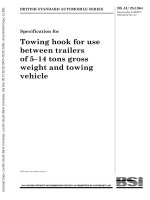Bsi bs c 22 1995 (2000) iso 9475 1994
Bạn đang xem bản rút gọn của tài liệu. Xem và tải ngay bản đầy đủ của tài liệu tại đây (331.74 KB, 11 trang )
BRITISH STANDARD AEROSPACE SERIES
Test methods for
aircraft inner tube and
tubeless tyre valves —
Cores and caps
Reprodu ced by I H S u n d er l i cen se wi th BSI - U n con trol l ed Copy
BS C 22:1995
ISO 9475:1994
BS C 22:1995
Committees responsible for this
British Standard
The preparation of this British Standard was entrusted to Technical
Committee ACE/59, Aircraft tyres, rims and associated equipment, upon which
the following bodies were represented:
British Airways
British Rubber Manufacturers’ Association Ltd.
Civil Aviation Authority (Airworthiness Division)
Ministry of Defence
Retread Manufacturers’ Association
Society of British Aerospace Companies Ltd.
This British Standard, having
been prepared under the
direction of the Engineering
Sector Board (E/- ) , was
published under the
authority of the Standards
Board and comes
into effect on
1 5 April 1 995
© BSI 01 - 2000
The following BSI references
relate to the work on this
standard:
Committee reference ACE/59
Draft for comment 93/71 01 05 DC
ISBN 0 580 24046 0
Reprodu ced by I H S u n d er l i cen se wi th BSI - U n con trol l ed Copy
Amendments issued since publication
Amd. No.
Date
Comments
BS C 22:1995
Contents
Page
Committees responsib le
National foreword
© BSI 01 - 2 000
ii
1
Scope
1
2
Normative references
1
3
General
1
4
Valve cores
1
5
Tyre valve caps
3
Figure 1 — Manifold
2
Table 1
3
Table 2
3
List of references
Reprodu ced by I H S u n d er l i cen se wi th BSI - U n con trol l ed Copy
Inside front cover
Inside back cover
i
BS C 22:1 995
National foreword
This British Standard has been prepared by Technical Committee ACE/59. It is
Aircraft inner tube and tubeless tyre valves —
Cores and caps — Test methods, published by the International Organization
identical with ISO 9475: 1 994,
for
Standardization (ISO).
Cross-references
International Standard
ISO 81 5: 1 991
C orresponding British Standard
Physical testing of rubber
Method for determination of compression
set at ambient, elevated or low temperatures
BS 903
Part A6: 1 992
(Identical)
ISO 868: 1 985
Methods of testing plastics
Mechanical properties
Method 365 B: 1 992 Determination of indentation
hardness by means of a durometer (Shore hardness)
BS 2782
Part 3
The Technical Committee has reviewed the provisions of ISO 37: 1 994 and
ISO 48: 1 994, to which normative reference is made in the text, and has decided
that they are acceptable for use in conj unction with this standard.
A British Standard does not purport to include all the necessary provisions of a
contract. Users of British Standards are responsible for their correct application.
Compliance with a British Standard does not of itself confer immunity
from legal obligations.
Summary of pages
This document comprises a front cover, an inside front cover, pages i and ii,
pages 1 to 4, an inside back cover and a back cover.
This standard has been updated (see copyright date) and may have had
amendments incorporated. This will be indicated in the amendment table on the
inside front cover.
ii
Reprodu ced by I H S u n d er l i cen se wi th BSI - U n con trol l ed Copy
© BSI 01 - 2000
BS C 2 2 : 1 995
1 S cop e
This International Standard specifies the test
methods used for valve cores and caps for aircraft
tyres, with or without inner tubes, and minimum
airtightness standards. It constitutes a detailed
method allowing products to be evaluated on the
same basis, and results to be compared.
2 Normative re fe re nce s
The following standards contain provisions which,
through reference in this text, constitute provisions
f) environmental tests at constant high
temperature (4 . 4 . 6 ) ;
g) environmental tests at peak high
temperature (4 . 4 . 7 ) .
4 . 2 Minimum airtightne ss re quire me nts
Valve cores shall be rej ected if the leakage rate
3
during tests is greater than 0, 2 cm /min.
4 . 3 Ge ne ral te st conditio ns
Unless otherwise specified, all tests shall be
conducted under the following conditions:
of this International Standard. At the time of
a) ambient temperature and pressure;
publication, the editions indicated were valid. All
b) valve cores shall be installed in a six- position
standards are subj ect to revision, and parties to
agreements based on this International Standard
are encouraged to investigate the possibility of
applying the most recent editions of the standards
indicated below. Members of IEC and ISO maintain
registers of currently valid International Standards.
Rubber, vulcanized or
thermoplastic — Determination of tensile
stress-strain properties.
ISO 37: 1 994,
Rubber, vulcanized or
thermoplastic — Determination of hardness
(hardness between 10 IRHD and 1 00 IRHD).
ISO 48: 1 994,
Rubber, vulcanized or
thermoplastic — Determination of compression set
at ambient, elevated or low temperatures.
ISO 81 5: 1 991 ,
Plastics and ebonite —
Determination of indentation hardness by means of
a durometer (Shore hardness).
ISO 868: 1 985,
manifold as shown in Figure 1 ;
c) tightening torques for cores with elastomeric
valve seats shall be between 0, 1 7 N·m
and 0, 34 N·m;
d) tightening torques for cores with metal
(or elastomeric plus metal stop) valve seats shall
be between 0, 34 N·m and 0, 54 N·m;
e) the pressure inside the manifold shall
be 3 800 kPa;
f) airtightness shall be verified by immersing the
core in water, acetone or alcohol.
4 . 4 Te st me thod s
4.4.1
Tightening torque test
4.4.1 .1
Test conditions
a) Carry out the test on six cores installed in a
manifold in accordance with Figure 1 .
b) Tighten the cores to the minimum torque
3 Ge ne ral
For the test methods, the requirements laid down
under the test conditions are obligatory. The
procedure and certain additional performance
requirements shall be fixed by agreement between
the valve manufacturer and the client, with an
obligation to meet the minimum airtightness
requirements defined in this International
Standard.
specified in
4.3.
c) The test pressure is 200 kPa to 3 800 kPa.
4.4.1 .2
Performance requirement
The core leak- rate shall not be greater than the
value set in
4.2
throughout the pressure range.
Checks shall be made at least at the minimum and
maximum pressures.
4.4.2
Washout test
This test simulates rapid deflation at high pressure.
4 Valve core s
4.4.2.1
Test conditions
4 . 1 Typ e s o f te sts
a) Carry out this test on cores which have
Aircraft tyre valve cores shall be submitted to the
successfully passed the tightening torque
following tests:
a) tightening torque test (4 . 4 . 1 );
b) washout test (4 . 4 . 2 );
c) blowout test (4 . 4 . 3 );
d) pressurized pulse test (4 . 4 . 4 ) ;
e) environmental tests at low
temperature (4 . 4 . 5 );
© BSI 01 - 2000
Reprodu ced by I H S u n d er l i cen se wi th BSI - U n con trol l ed Copy
test (4 . 4 . 1 ).
b) Set the manifold pressure to 3 800 kPa.
c) Carry out 1 0 test cycles, defined as follows, on
each valve core:
1 ) open each core manually and keep it open for
at least 3 s to allow the pressurized air to
escape at high speed across the valve seal;
2) allow the core to close freely.
1
BS C 2 2 : 1 995
Figure 1 — Manifold
4.4.2.2
Performance requirement
b) Carry out the pulse tests on the valve cores in
The leak- rate, measured after 1 0 cycles, shall not be
greater than the value specified in
4.4.3
Blowout test
4.2 .
4.4.4.2
Performance requirement
Throughout the test, the leak- rate shall not be
This test simulates rapid inflation at high pressure.
4.4.3.1
accordance with Table 1 .
Test conditions
greater than the value set in
4.4.5
a) Carry out this test on the cores that have
passed the tightening torque test (4 . 4 . 1 ) and the
4.2.
It shall be noted
after every 1 000 cycles.
Environmental test at low temperature
4.4.5.1
Test conditions
washout test (4 . 4 . 2 ).
a) Carry out this test on six new cores installed in
b) Carry out 1 0 test cycles, defined as follows, on
a test manifold in accordance with Figure 1 .
each valve core:
b) Hold the cores at a temperature of – 54 ° C
1 ) reduce the manifold pressure to 0 kPa;
for 24 h.
2) attach a standard connector to a 3 800 kPa
c) Check the airtightness in acetone or alcohol
compressed air system;
3) keep each core open for at least 3 s to allow
the pressurized external air to enter the
d) After cooling, check the airtightness at each of
manifold at high speed across the valve seal;
the following stages, in the order indicated:
4) after 3 s, remove the inflation connector and
1 ) at 3 800 kPa; if the core leaks, retighten to
let the core close freely.
the maximum torque defined in
4.4.3.2
Performance requirement
Pressurized pulse test
4.4.4.1
4.2 .
Test conditions
a) Carry out this test on six new cores installed in
a manifold in accordance with Figure 1 .
2
Reprodu ced by I H S u n d er l i cen se wi th BSI - U n con trol l ed Copy
4.3;
2) washout test (4 . 4 . 2 ) ;
The leak- rate, measured after 1 0 cycles, shall not be
greater than the value specified in
4.4.4
cooled to – 54 ° C, with air cooled to – 54 ° C at a
pressure of 3 800 kPa.
3) blowout test ( 4 . 4 . 3 );
4) at 200 kPa;
5) at 620 kPa;
6) at 1 380 kPa;
7) at 3 800 kPa.
Perform seven test cycles at each pressure.
© BSI 01 - 2000
BS C 2 2 : 1 995
Tab le 1
Pre ssu re
O p e rati o n
kPa
min. a
High-pressure cycle 1 380
Normal cycle
620
Low-pressure cycle 200
max.
3 800
1 380
620
C ycle s p e r mi nute
co nd i ti o n
35
35
5
a Never let the pressure fall below the indicated minimum pressures.
4.4.5.2
Performance requirement
To tal cycle in this
1 000
1 000
1 000
c) ageing test ( );
d) screwing/unscrewing test (
5.3.3
).
Under each test condition, the leak-rate shall not be
greater than the value set in .
Environmental test at constant high
No leakage is acceptable during the various
temperature
airtightness checks. Leaking caps shall be rejected.
5.3.4
4.2
5 . 2 Minimum airtightne ss re quire me nt
4.4.6
4.4.6.1
Test conditions
5 . 3 Te st me thod s
a) Carry out this test on the same cores as passed
Mechanical properties of gasket
the low-temperature test ( ).
materials
b) Place them in an oven and increase the
Test conditions
temperature to + 93 °C. Hold this for 24 h.
a) Determine the following initial properties of
c) Cool the samples to + 52 °C and check the
the gasket material as indicated:
airtightness in water at + 52 °C with air
— breaking strength, in accordance with
at + 52 °C at a pressure of 3 800 kPa.
ISO
37;
d) Then follow the test procedure in
d).
—
elongation
in accordance with ISO 37;
Performance requirement
— hardness in accordance with ISO 48 or
Under each test condition, the leak-rate shall not be
ISO 868;
greater than the value set in .
— compression set in accordance with
Environmental test at peak temperature
ISO 815.
Test conditions
b) Determine the properties of the seal again
after
oven-ageing at + 93 °C for 7 days.
a) Carry out this test on the same cores as passed
the low-temperature test ( ) and constant
Performance requirements
high-temperature test ( ).
Variations in tensile strength, elongation and
b) Place them in an oven and increase the
hardness characteristics determined after
temperature to + 120 °C. Hold this for 20 min.
oven-heating shall not differ from initial
characteristics by more than the maximum
c) Cool the samples to + 52 °C and check the
variation values given in Table 2.
airtightness in water at + 52 °C with air
at + 52 °C at a pressure of 3 800 kPa.
d) Then follow the test procedure
in
d), 10 times.
max.
max.
Performance requirement
Tensile strength —
20 %
Under each test condition, the leak-rate shall not be Elongation
—
30 % or 40 %
greater than the value set in .
(to be specified)
Shore A hardness 10 %
—
Temperature resistance test
Test conditions
Aircraft tyre valve caps shall be submitted to the
following tests:
a) Carry out this test on six valve caps.
a) determination of mechanical properties of seal
b) The service temperature range is – 54 °C
material ( );
to + 93 °C with a 24-h holding period at each of
these two temperatures.
b) temperature resistance test ( );
5.3.1
4.4.5
5.3.1 .1
4.4.5.1
4.4.6.2
4.2
4.4.7
4.4.7.1
4.4.5
5.3.1 .2
4.4.6
Tab le 2
Incre ase
D e cre ase
C haracte ristic
4.4.5 .1
4.4.7.2
4.2
5 Tyre valve cap s
5.3.2
5 . 1 Te st typ e s
5.3.2.1
5.3.1
5.3.2
© BSI 01-2000
Reprodu ced by I H S u n d er l i cen se wi th BSI - U n con trol l ed Copy
3
BS C 2 2 : 1 995
c) The cap tightening torque is b etween 0, 56 N·m
Carry out at least five of the
and 0, 79 N·m.
screwing/unscrewing cycles at – 54
d) The test pressure is up to 3 800 kPa.
5.3.2.2
Performance requirements
The requirement in 5 . 2 shall be met within the
temperature and torque tightening range for
pressures of up to 3 800 kPa.
5.3.3
Ageing test
Test conditions
minimum of 72 h. The caps shall not b e screwed
onto the valve body during this 72 - h hold period
at – 54
°C.
c) Screw the caps which have undergone 1 0
screwing/unscrewing cycles b ack onto the valve
body and torque them to between 0, 56 N·m
a) Carry out this test on six valve caps.
b) Place the caps in an oven and increase the
5.3.3.2
on caps
and 0, 79 N·m.
5.3.3.1
temperature to + 93
°C
which have b een held at this temperature for a
° C.
Hold this for 7 days.
Performance requirements
d) Apply a pressure of 70 kPa and hold it for 1 h.
e) Apply a pressure of 3 800 kPa and hold it
for 1 h.
f) With the caps still tightened onto the valve
body with the same torque, cool them to – 5 4
°C
After oven heating, the requirement in 5 . 2 shall be
and hold this temperature for 2 4 h, applying an
met.
internal pressure to the cap of at least 3 800 kPa.
5.3.4
Screwing unscrewing test
Test conditions
/
5.3.4.1
a) Carry out this test on three new caps and three
caps aged in accordance with 5 . 3 . 3 .
b) Screw the caps down with a torque
5.3.4.2
Performance requirements
The requirement in 5 . 2 shall be met during
stages 5 . 3 . 4 . 1 d) , 5 . 3 . 4 . 1 e) and 5 . 3 . 4 . 1 f) . In
addition, after this test, the seal shall rotate freely
within the cap without becoming unseated.
of 0, 56 N·m 1 0 times, unscrewing them each
time, ensuring that the seals break contact with
the valve mouth.
4
Reprodu ced by I H S u n d er l i cen se wi th BSI - U n con trol l ed Copy
© BSI 01 - 2 000
BS C 22:1995
List of references
See national foreword.
© BSI 01 - 2 000
Reprodu ced by I H S u n d er l i cen se wi th BSI - U n con trol l ed Copy
BS C 22:1995
ISO 9475:1994
BSI — British Standards Institution
BS I is the indep endent national b ody res p ons ib le for p rep aring
Britis h S tandards . It p res ents the UK view on s tandards in E urop e and at the
international level. It is incorp orated b y Royal C harter.
Revisions
Britis h S tandards are up dated b y amendment or revis ion. Us ers of
Britis h S tandards should make s ure that they p oss es s the latest amendments or
editions .
It is the constant aim of BS I to imp rove the quality of our p roducts and services .
We would b e grateful if anyone finding an inaccuracy or amb iguity while us ing
this Britis h S tandard would inform the S ecretary of the technical committee
res p ons ib le, the identity of which can b e found on the inside front cover.
Tel: 02 0 89 96 90 00. Fax: 02 0 89 96 7 40 0 .
BS I offers memb ers an individual up dating s ervice called PLUS which ens ures
that s ub s crib ers automatically receive the lates t editions of s tandards .
Buying standards
O rders for all BS I, international and foreign s tandards p ub lications s hould b e
addres s ed to C us tomer S ervices. Tel: 0 2 0 899 6 9 00 1 . Fax: 0 2 0 899 6 7001 .
In res p ons e to orders for international standards , it is BS I p olicy to sup p ly the
BS I imp lementation of thos e that have b een p ub lis hed as Britis h S tandards,
unless otherwis e requested.
Information on standards
BS I p rovides a wide range of information on national, E urop ean and
international standards through its Lib rary and its Technical H elp to E xp orters
S ervice. Various BS I electronic information s ervices are also availab le which give
details on all its p roducts and s ervices . C ontact the Information C entre.
Tel: 02 0 89 96 71 1 1 . Fax: 02 0 89 96 7 048.
S ub s crib ing memb ers of BS I are kep t up to date with s tandards develop ments
and receive sub s tantial discounts on the p urchase p rice of s tandards. For details
of thes e and other b enefits contact Memb ership Adminis tration.
Tel: 02 0 89 96 70 02 . Fax: 02 0 89 96 7 00 1 .
Copyright
C op yright s ub s is ts in all BS I p ub lications . BS I als o holds the cop yright, in the
UK, of the p ub lications of the international s tandardization b odies . E xcep t as
p ermitted under the C op yright, D es igns and Patents Act 1 988 no extract may b e
rep roduced, s tored in a retrieval s ystem or transmitted in any form or b y any
means – electronic, p hotocop ying, recording or otherwis e – without p rior written
p ermis s ion from BS I.
This does not p reclude the free us e, in the cours e of imp lementing the standard,
of necess ary details such as s ymb ols, and size, typ e or grade designations. If thes e
details are to b e used for any other p urp os e than imp lementation then the p rior
written p ermiss ion of BS I must b e ob tained.
If p ermis sion is granted, the terms may include royalty p ayments or a licensing
agreement. D etails and advice can b e ob tained from the C op yright Manager.
BS I
3 89 C his wick H igh Road
London
W4 4AL
Reprodu ced by I H S u n d er l i cen se wi th BSI - U n con trol l ed Copy
Tel: 02 0 89 96 70 7 0.




